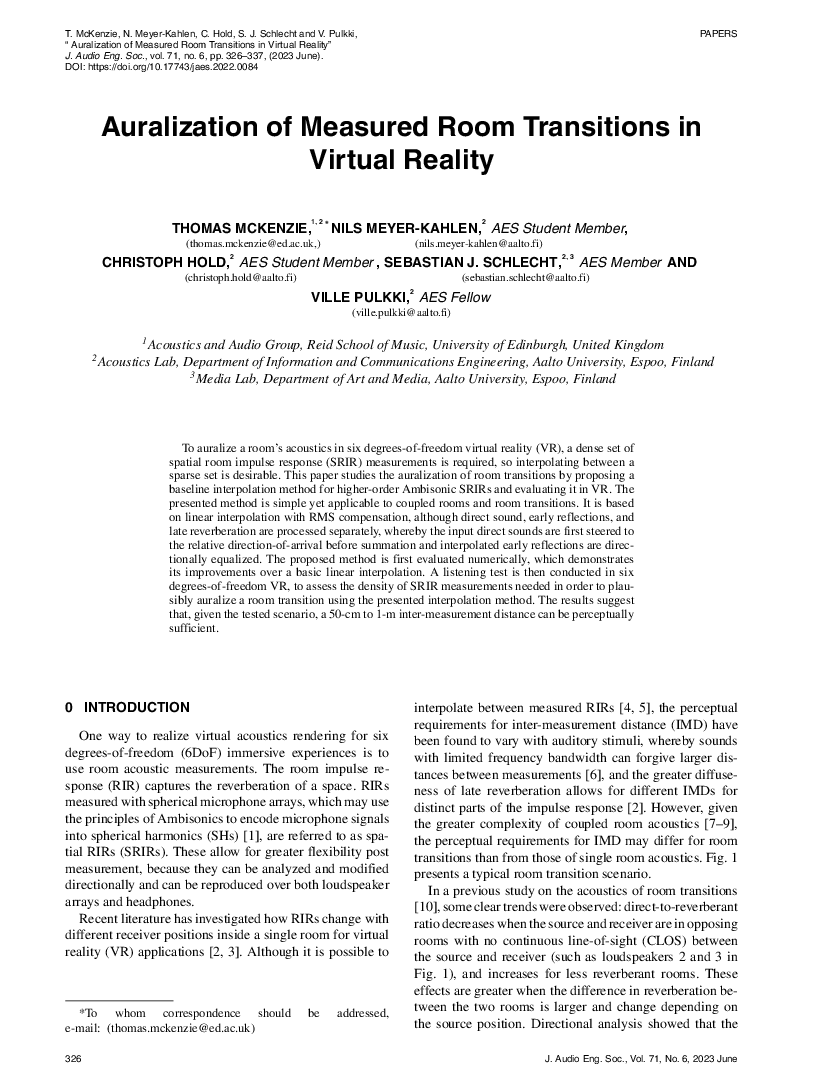Home / Publications / E-library page
You are currently logged in as an
Institutional Subscriber.
If you would like to logout,
please click on the button below.
Home / Publications / E-library page
Only AES members and Institutional Journal Subscribers can download
To auralize a room`s acoustics in six degrees-of-freedom virtual reality (VR), a dense set of spatial room impulse response (SRIR) measurements is required, so interpolating between a sparse set is desirable. This paper studies the auralization of room transitions by proposing a baseline interpolation method for higher-order Ambisonic SRIRs and evaluating it in VR. The presented method is simple yet applicable to coupled rooms and room transitions. It is based on linear interpolation with RMS compensation, although direct sound, early reflections, and late reverberation are processed separately, whereby the input direct sounds are first steered to the relative direction-of-arrival before summation and interpolated early reflections are directionally equalized. The proposed method is first evaluated numerically, which demonstrates its improvements over a basic linear interpolation. A listening test is then conducted in six degrees-of-freedom VR, to assess the density of SRIR measurements needed in order to plausibly auralize a room transition using the presented interpolation method. The results suggest that, given the tested scenario, a 50-cm to 1-m inter-measurement distance can be perceptually sufficient.
Author (s): McKenzie, Thomas; Meyer-Kahlen, Nils; Hold, Christoph; Schlecht, Sebastian J.; Pulkki, Ville
Affiliation:
Acoustics and Audio Group, Reid School of Music, University of Edinburgh, United Kingdom; Acoustics Lab, Department of Information and Communications Engineering, Aalto University, Espoo, Finland; Acoustics Lab, Department of Information and Communications Engineering, Aalto University, Espoo, Finland; Acoustics Lab, Department of Information and Communications Engineering, Aalto University, Espoo, Finland; Acoustics Lab, Department of Information and Communications Engineering, Aalto University, Espoo, Finland; Media Lab, Department of Art and Media, Aalto University, Espoo, Finland; Acoustics Lab, Department of Information and Communications Engineering, Aalto University, Espoo, Finland
(See document for exact affiliation information.)
Publication Date:
2023-06-06
Import into BibTeX
Permalink: https://aes2.org/publications/elibrary-page/?id=22140
(877KB)
Click to purchase paper as a non-member or login as an AES member. If your company or school subscribes to the E-Library then switch to the institutional version. If you are not an AES member Join the AES. If you need to check your member status, login to the Member Portal.

McKenzie, Thomas; Meyer-Kahlen, Nils; Hold, Christoph; Schlecht, Sebastian J.; Pulkki, Ville; 2023; Auralization of Measured Room Transitions in Virtual Reality [PDF]; Acoustics and Audio Group, Reid School of Music, University of Edinburgh, United Kingdom; Acoustics Lab, Department of Information and Communications Engineering, Aalto University, Espoo, Finland; Acoustics Lab, Department of Information and Communications Engineering, Aalto University, Espoo, Finland; Acoustics Lab, Department of Information and Communications Engineering, Aalto University, Espoo, Finland; Acoustics Lab, Department of Information and Communications Engineering, Aalto University, Espoo, Finland; Media Lab, Department of Art and Media, Aalto University, Espoo, Finland; Acoustics Lab, Department of Information and Communications Engineering, Aalto University, Espoo, Finland; Paper ; Available from: https://aes2.org/publications/elibrary-page/?id=22140
McKenzie, Thomas; Meyer-Kahlen, Nils; Hold, Christoph; Schlecht, Sebastian J.; Pulkki, Ville; Auralization of Measured Room Transitions in Virtual Reality [PDF]; Acoustics and Audio Group, Reid School of Music, University of Edinburgh, United Kingdom; Acoustics Lab, Department of Information and Communications Engineering, Aalto University, Espoo, Finland; Acoustics Lab, Department of Information and Communications Engineering, Aalto University, Espoo, Finland; Acoustics Lab, Department of Information and Communications Engineering, Aalto University, Espoo, Finland; Acoustics Lab, Department of Information and Communications Engineering, Aalto University, Espoo, Finland; Media Lab, Department of Art and Media, Aalto University, Espoo, Finland; Acoustics Lab, Department of Information and Communications Engineering, Aalto University, Espoo, Finland; Paper ; 2023 Available: https://aes2.org/publications/elibrary-page/?id=22140
@article{mckenzie2023auralization,
author={mckenzie thomas and meyer-kahlen nils and hold christoph and schlecht sebastian j. and pulkki ville},
journal={journal of the audio engineering society},
title={auralization of measured room transitions in virtual reality},
year={2023},
volume={71},
issue={6},
pages={326-337},
month={june},}